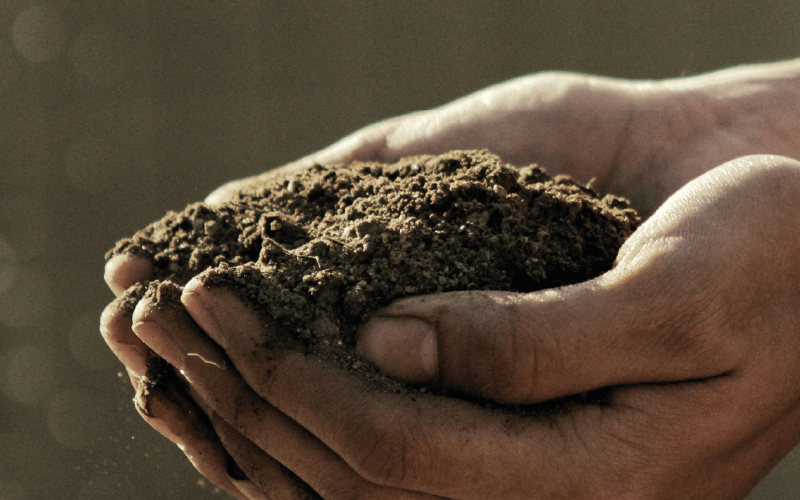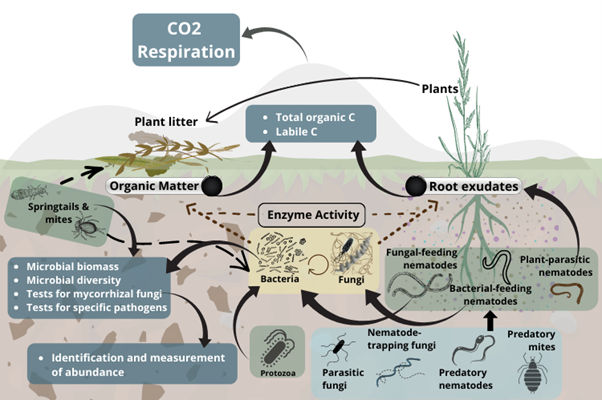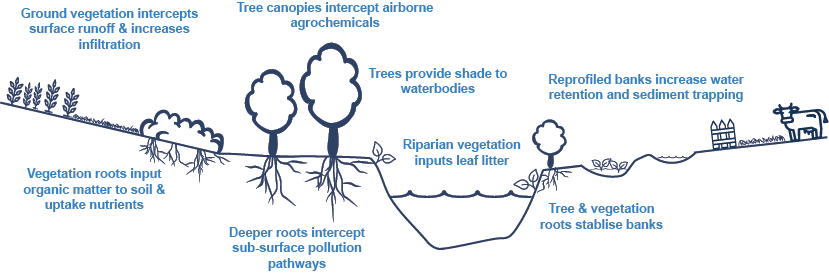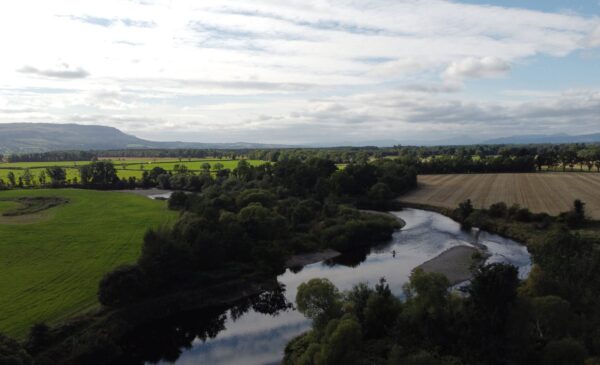Regenerative agriculture, takes a holistic approach to farm management, focusing on enhancing ecosystem functions through restoring ecosystem health and promoting diversity through the five core principles shown in Figure 9.
By incorporating the five core principles of regenerative agriculture (see Figure 9), farmers can work to improve soil health on farm. The resulting impact on improving biodiversity and the benefits this can relay into the health of the farm and pest control. Regenerative agriculture works to restore ecosystem functions, focusing on improving soil health. By improving the soil health, the benefits cascade throughout the sector, enhancing the natural capital.
Figure 9: The five core principles of regenerative agriculture
Farming for a Better Climate have produced practical guides and information on the five core principles, looking at ways to practically implement them within the farm.
There are a variety of cultivation techniques that can be used, which minimise disturbance to the soil. These include no-till and a range of other minimum tillage systems (e.g. strip till), often referred to as conservation tillage.
These approaches strive to cultivate the land using alternative methods that result in reduced, little or no soil disturbance compared to conventional ploughing. The benefits and disadvantage of these techniques can be seen in Table 3.
Table 4 Benefits and disadvantages to Min-till/no-till cultivation.
| Benefits | Disadvantages |
| Improved soil health. | Not suitable for all soil types. |
| Reduces damage to soil structure. | Requires specialist machinery. |
| Allows soil to retain water. | Establishment issues with root crops. |
| Reduce soil erosion. | Weed control. |
| Retains nutrients within the soil. | Pest control. |
| Retain soil organic content. | Slow dry out in spring can occur. |
| Reduces damage to organisms within the soil. | |
| Reduces labour and fuel. |
Maintaining a vegetated cover protects and enhances soil. By allowing soil to be covered and not bare, roots can bind soil together making the structure more resilient to water and wind erosion. The above ground vegetation acts as a barrier, covering the soil and reducing the impact of wind and water erosion and keeping soils on the farm. Improved soil structure can retain and slow water flow through the land. This can result in reduce runoff of nutrients and soil, resulting in reduced erosion. Leading to decreased soil loss and can result in nutrients remaining within the soil, resulting in healthier soil. For more information on cover crops click here.
Preserving a living root system promotes good soil structure and overall health. A matrix of root systems leads to reduced erosion as the soil is bound by root structure, nutrients can be utilised by the crop and remain in situ in the soil preventing leaching.
Living roots help promote a healthy soil food web, enhancing microbial activity within the soil and improving the health of the soil, as shown in figure 10.
Figure 10 Healthy soil food web. Image sourced from Farming for a Better Climate.
Potential options to improve living roots within your rotation could be through: cover crops; catch crops; stubbles; perennial crops and winter crops.
Monocultures within arable crops can be high yielding and easier to manage with larger machinery, however, this comes at a disadvantage when compared to a diverse cropping regime. Monoculture in natural ecosystems are extremely rare as they do not provide the variety and complexity, which is required to function, without intervention. Diversity allows for various species to utilise and benefit the soil. With various root depths of plant species to different microorganisms within the soil, variety makes for healthier more sustainable soil.
Introducing other crop mixtures on your land can help to improve soil health.
Legumes
Can fix nitrogen from the atmosphere into a form that crops and plants can take up, therefore, contributing to soil fertility building and reducing the reliance on synthetic fertiliser applications.
Silvo arable systems
Trees are planted in rows, within arable fields. The trees provide shelter to the crop, while the root structure can penetrate to different depths within the soil than the crops. This variation in roots offers better soil structure, increased infiltration and increase water retention on field. The trees can additionally provide a cash crop for timber or fruit depending on the variety of tree.
For more information on how to include trees within your land Farm Advisory Service (FAS) have created a woodland creation page here with links to guidance information, videos and podcasts.
By incorporating hedgerows within your fields you are providing shelter and improving the soil structure to the soil. Hedgerows can provide habitats for predator species, contribute to carbon sequestration and enhance soil structure, especially during times when crops are establishing and the soil has less root structure to protect it. The Farm Advisory Service have produced multiple guidance documents on improving hedgerows and their management.
Buffer strips along watercourses GAEC 1
The inclusion of minimum legal working distances from watercourses creates a buffer between in-field practices and watercourses on the farm. The Scottish Government’s Rural Payments and Services website has created an information page on buffer strips along watercourses, which can be found here.
Buffer strips are primarily uncultivated strips of vegetated land between the field edge and watercourses (or other sensitive habitats). Buffer strips vary in width and composition depending on the function.
Managed buffer strips can provide plenty of benefits to farm soils, watercourses and livestock. Well vegetated buffer strips van reduce nutrients entering watercourses, by intercepting below ground flow or surface runoff, trapping soil particles in above ground vegetation. In addition, they provide benefits to biodiversity, for example through providing shelter and/or food sources for beneficial insects to additional habitats or corridors aiding wildlife movement around the farm. There are a variety of buffer strips that can be created on farm to suit your land.
3D Buffers
3D buffers (Figure 11) are an integrated system for riparian areas designed to build on the existing benefits of current buffer strips. They work by integrating above, surface and below ground mitigation measures to help to combat problems such as excess nutrient loading, saturated buffers, or sub-surface pollution pathways.
3D buffers are custom designed to their location and their widths can vary, between 6-12 meters where needed, depending on pollution pressure (for example preferential flow pathways), status of waterbody and ecological goals.
As 3D buffer strips combine the benefits of grassy and woody buffers, they can also provide additional benefits to farm businesses and increase biodiversity. Examples include the shading of rivers, providing habitats for natural pest predators and sequestering carbon.
Figure 11 Overview of potential benefits of 3D buffer components.
To learn more about 3D buffers the Farm Advisory Service have produced video and guidance information on these systems. In addition, you can listen to Exploring Ecosystem Service of 3D buffer Strips here.
The introduction of livestock to arable systems can be of great benefit to improving the organic matter of the soil. By allowing livestock into the arable rotation, nutrients and minerals can be replenished and gives soil time to recover. Farming for a Better Climate and the Farm Advisory Service have produced material highlighting the practicalities of introducing livestock and the information land managers should be aware of before introducing livestock into their business.
Further information
- SAC Consulting have produced practical guides looking at precision farming and regenerative agriculture within arable, extensive and productive farming systems.
- https://www.fas.scot/publication/regenerative-agriculture-integrating-livestock/
- https://www.farmingforabetterclimate.org/resource/integrating-livestock/








